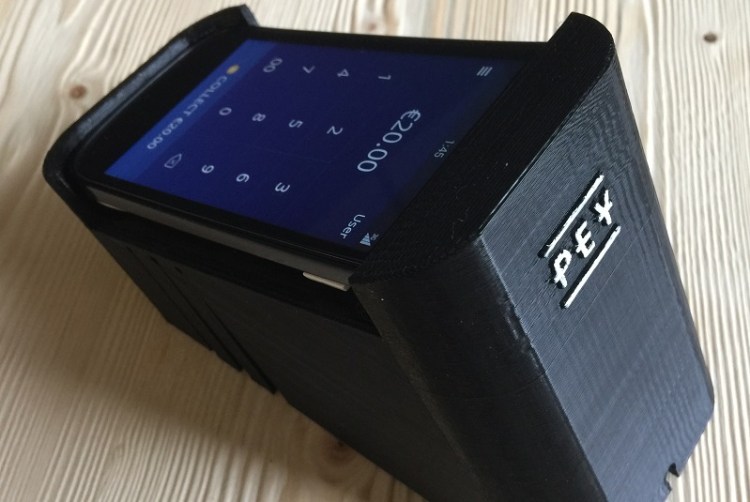In Hanover, Germany, a new company is using Bitcoin to get electronic payments accepted by local merchants.
Most restaurants and stores in Hanover only accept cash. Credit cards are not the phenomenon they are in the States, and merchants have to pay very high fees to accept debit cards. That means consumers always have to carry cash. But serial entrepreneur Ricardo Ferrer Rivero decided he wanted more options. Rather than work with banks, Rivero reasoned that getting merchants to accept Bitcoin could be a workable solution.
So he gathered a few local technologists, developers, and industrial designers to create a 3D-printed Bitcoin point of sale that doesn’t cost a thing to use.
The project came together because Rivero had extra time on his hands after one of his companies sold to Atlassian. He asked merchants what it would take for them to accept Bitcoin, and they said their major concern was that working with Bitcoin would be too complex and that the currency was too volatile.
So Rivero, a perpetual tinkerer, started thinking and talking to friends about the project. The idea was to develop a Bitcoin standard that every wallet could integrate with, so it would be easy to use for consumers. The product also had to be simple and low risk for merchants.
Using old Google Nexus 7 phones bought off eBay, he and some friends got to work. They first installed a new version of Android and then customized both the software and hardware. BitPay agreed to work with them as the payment processor and also developed a tailored system for Hanover’s merchants that lowered risk from Bitcoin price fluctuation. But the customer experience needed work. In order to get Android phones enabled with NFC to communicate with other NFC devices, you have to put them back to back.
“Its kind of awkward,” said Rivero. With a little soldering, he and his colleagues reconfigured the device so that the merchant could punch in the cost of the item, and created a surface where the customer could easily approach with their phone and tap to have their transaction information transferred over. It was a crude hack, but it worked. Meanwhile the industrial design team had created 3D-printed housing for the phone.
While the company was in the midst of tweaking its POS, Apple’s NFC enabled mobile payment option, Apple Pay, rolled out. It immediately raised Rivero’s expectations for how his mobile payment platform should be.
“We wanted to reach that standard of usability,” said Rivero. “But I noticed it wasn’t going to be possible through the normal channels.”
Apple Pay enables users to open their phone and pay in-store with the touch of button. While there are criticisms of how well Apple Pay works in practice, it’s still fairly elegant compared with other mobile pay experiences. To get a similar effect, Rivero and his team installed an iBeacon on terminals, so that when consumers get within a few feet of the iBeacon, a push notification gets sent to their phone. Clicking on the link automatically opens an app to facilitate the transaction. But, in order to get the wallets to auto-launch, Ferrer needed to collaborate with existing wallets like Coinbase or Blockchain. He also had a self-imposed time constraint: He wanted to get this thing up and running in a few weeks’ time.
The Bitcoin wallets Rivero had reached out to were enthusiastic about the project but could not commit to putting together a solution in a such a short period of time. Luckily, around the same time, an iOS developer reached out to Ferrer expressing interest in joining the project. That’s when Ferrer and his crew decided to build their own app that would launch whatever Bitcoin wallet the user linked to it.
What started as a project has turned into a company, called Pey. So far, 50 Hanover merchants have agreed to accept Bitcoin, and 12 units have already been installed in stores. But, Rivero wants to grow that number to 100. Merchants have good reason to sign-up: Pey is giving the terminal and its software away for free as well as providing the Internet connection.
“We currently charge no fee, basically because we see ourselves as a hardware company. So we’re giving it to people and trying to learn from it,” said Rivero.
Eventually the company plans to sell the terminal — or potentially lease it — but it’s still working out the details. In any case, it will likely be a while before Pey starts charging for its system. In the meantime, it’s building a beta ecosystem where the company can test and tweak until it’s ready to roll out a finished product. Already the company is working on a next generation version of the terminal built on Raspberry Pi.
Pey is also going to start raising capital.
Perhaps most striking about Pey is that it’s using Bitcoin to solve an actual problem. In places like the U.S. and U.K., which have their own ecosystem of Bitcoin companies, there isn’t a lot of need for Bitcoin. Banking infrastructure is strong, credit is plentiful, and there are a variety of ways to transact money digitally. But in Hanover, Pey has the potential to solve the problem of enabling cashless transactions without having to change the region’s existing banking infrastructure. If Pey can target more regions like Hanover, it may have some real potential to grow.
*Updated: An earlier version of this article left off Ricardo Ferrer’s last name, Rivero.


